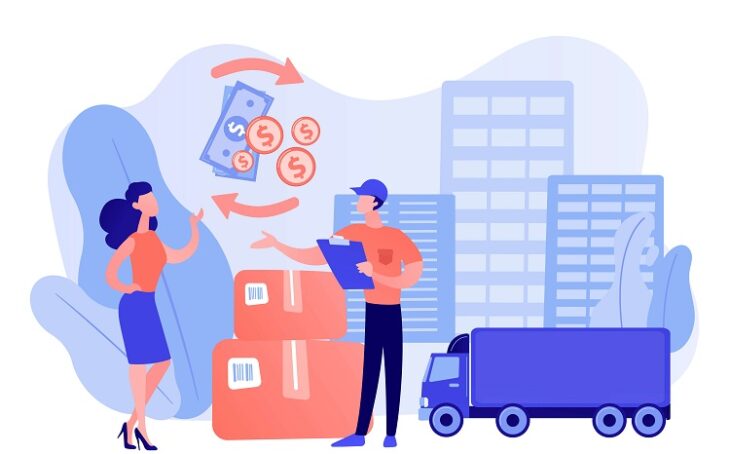nline sales with US merchants reached a staggering $550 billion, but the rate of returns has also increased. Between 2019 and 2020, eCommerce returns more than doubled, resulting in $102 billion worth of items being returned.
To handle this surplus, major online retailers like Amazon liquidate returned products. Interestingly, many returns are in new and unopened condition, making them valuable for buyers.
These items are sold through online liquidation marketplaces, providing an opportunity to access unused and unclaimed goods. If you’re interested in learning more, continue reading.
Table of Contents
ToggleWhat is Amazon Return Pallets?
Amazon return pallets are pallets of goods that have been returned to Amazon.
They are sold unseen at vastly discounted prices to anyone willing to take the risk.
The potential for making a lot of money is substantial, simply by refurbishing and reselling the items.
The more you can afford to buy, the cheaper the price.
Returned items (liquidated items) from Amazon are typically sold by pallet or truckload.
Therefore, Amazon return pallets refer to pallet sales consisting of products that have been returned to Amazon. These pallets are sold at discounted prices to sellers who are willing to take the risk, without having seen the contents beforehand.
Are the Amazon Return Pallets real?
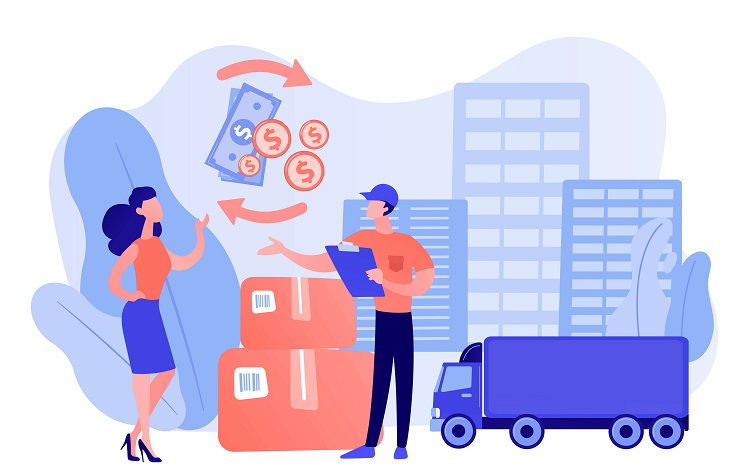
Amazon return pallets are real containers or packages of products that have been returned to Amazon.
These pallets are legitimate, but there is no guarantee that they will contain high-quality or usable items.
It is important to carefully inspect the contents of the pallet before purchasing to ensure that you are getting the value for your money.
Why Buy Amazon Customer Return Pallets?
There are some excellent reasons you might want to consider the Amazon Return Pallets experience.
First, you don’t need to make a considerable investment. A few hundred dollars will do to get started.
You could even begin with a line of credit instead.
The reselling avenues are numerous, for example, flea markets, and resale platforms such as Thredup, Poshmark, OfferUp, eBay, and many more.
If you already own or are starting a business, purchasing return pallets is an excellent way to build up your inventory.
The pallets are sold in bulk and typically contain various products, from clothing and electronics to beauty products.
If you want to, you can specialize in a specific category.
Alternatively, if you sell in multiple categories, it will be an opportunity to see what your customers prefer.
- Low investment: You can get started with a few hundred dollars, making it accessible for small-scale buyers.
- Potential for high-profit margins: Buying customer return pallets can offer significant profit potential if you find valuable items or resellable merchandise.
- Variety of items: Customer return pallets contain a diverse range of products, providing options to cater to different markets and customer preferences.
- Potential for brand-name products: There is a chance of finding brand-name items within customer return pallets, offering the opportunity to acquire popular and recognizable products.
- Sustainable option: Buying and reselling customer return pallets contributes to reducing waste and promoting a circular economy by giving unused items a second chance.
How Much Does it Cost to Buy Amazon Return Pallets?
The cost of an Amazon Return Pallet varies depending on the size and contents of the pallet. Generally, a full pallet of Amazon returns can range from $300 to $400. Some can range for as high as $10,000.
For example, as of September 2021, a quick search on a popular online liquidation marketplace showed a pallet of Amazon customer returns listed for around $500. The pallet contained various items, including electronics, home goods, toys, and more.
However, it’s important to note that prices can fluctuate based on market demand and other factors, so it’s recommended to research and compare prices from different sellers before making a purchase.
Pros and Cons of Buying Amazon Return Pallets
Pros of Buying Amazon Return Pallets:
- Potential for high-profit margins: If you find valuable items or resellable merchandise within the pallet, you can make a significant profit.
- Variety of products: Return pallets offer a diverse range of items, allowing you to cater to different markets and customer preferences.
- Access to brand-name items: There’s a chance of finding popular brand-name products within the pallets, which can attract customers and boost sales.
- Environmental sustainability: Buying and reselling customer returns promotes a circular economy by reducing waste and giving unused items a second chance.
Cons of Buying Amazon Return Pallets:
- Product condition: Some items may be damaged, defective, or missing parts, requiring additional effort for repair or refurbishment.
- Unpredictability: The contents of each pallet can vary, making it challenging to know the exact inventory and potential resale value.
- Potential competition: As more buyers enter the liquidation market, competition for desirable items and profitable deals increases.
- Lack of warranties: Many customer return items are sold “as-is,” without warranties, so you may assume the risk of potential defects or malfunctions.
- Limited customer support: Unlike buying directly from Amazon, support for issues related to customer returns may be limited or absent from liquidation sellers.
8 Best Ways to Buy Amazon Return Pallets 2024
In general, Amazon customer returns are sold on liquidation company websites.
So first, visit the websites, and you’ll find a list of all the vendors selling their liquidation stock.
Then, simply select “Amazon” under the “Marketplaces” or “By Seller” category.
Let’s take a look at some of the different liquidation companies.
Here are eight popular ways to buy Amazon return pallets in 2024:
- Amazon Liquidation Auctions (US)
- B-Stock Solutions (US and UK)
- Direct Liquidation (US and Canada)
- Liquidation.com (US)
- Bulq.com (US)
- Via Trading (US)
- Quicklotz (US)
- Wholesale Ninjas (US)
Buying Returns Pallets from Amazon Liquidation Auctions (US)
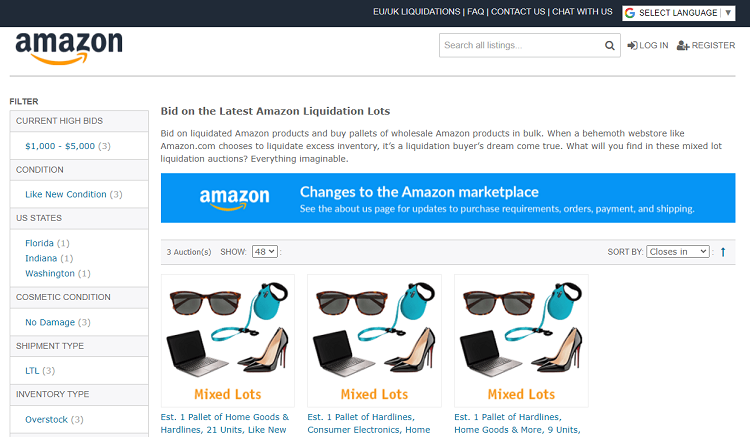
If you prefer to purchase a wide variety of items for your business, Amazon Liquidation Auctions (US) is a good choice.
Anyone with a registered US business can buy direct liquidation pallets from this website.
US-based buyers place bids on LTLs (Less Thank Truckloads) of overstock merchandise that might include:
- Home goods
- Books
- Apparel
- Groceries
- Electronic goods
- Accessories
- Footwear
You have to register and be approved by Amazon, but once that’s out of the way, you can bid and buy bulk lots of overstock inventory.
Pros:
- Wide variety of items: Amazon Liquidation Auctions offer a diverse range of products, including electronics, clothing, home goods, and more.
- Potential for high-quality items: Some returns may be in excellent condition or even brand new, providing opportunities to acquire valuable merchandise.
- Competitive pricing: Auctions allow buyers to bid on pallets, potentially securing pallets at lower prices compared to fixed-price platforms.
Cons:
- Limited inspection and guarantees: Buyers may not have the opportunity to thoroughly inspect individual items or receive guarantees on the condition or functionality of the products.
- Higher competition: Popular auctions can attract more bidders, increasing competition and potentially driving up prices.
- Shipping and logistics: Buyers are responsible for arranging shipping and handling logistics, which can incur additional costs and require coordination.
Buying Returns Pallets from Liquidation with B-Stock (UK)
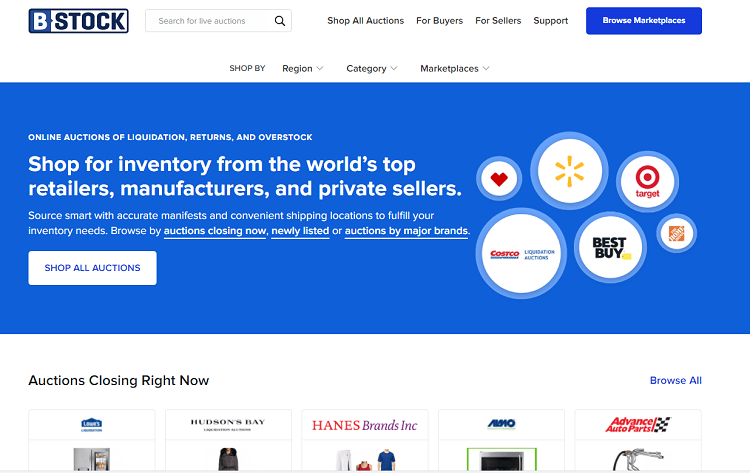
Amazon decided to partner with B-Stock to sell its return products in the UK.
B-Stock runs liquidation auctions in several countries but only sells Amazon products to the US and Europe.
The condition of the items on each pallet varies.
In some cases, they can vary from brand new to salvage.
Criteria vary for each marketplace, so you have to apply to each marketplace individually.
Shipping options and rates also vary, depending on the seller.
Some calculate shipping costs per pallet, while others offer free or flat-rate shipping.
Pros:
- Wide selection of used and unclaimed items: B-Stock offers a variety of returns pallets, including clothing, electronics, appliances, and more.
- Verified and reputable sellers: B-Stock partners with trusted liquidation companies, ensuring the quality and authenticity of the merchandise.
- Transparent buying process: Buyers have access to detailed information about each pallet, including manifest and condition notes, enabling informed purchasing decisions.
Cons:
- Potential for damaged or non-functional items: As with any returns pallet, there is a risk of receiving items that are defective, damaged, or missing parts.
- Limited warranty or returns policy: Depending on the seller, there may be limited or no warranty coverage or returns allowed for purchased pallets.
- Shipping and handling costs: Buyers are typically responsible for arranging and covering the costs of shipping and handling, which can vary based on location and pallet size.
Several other websites sell return pallets from Amazon and other online retailers.
Liquidation
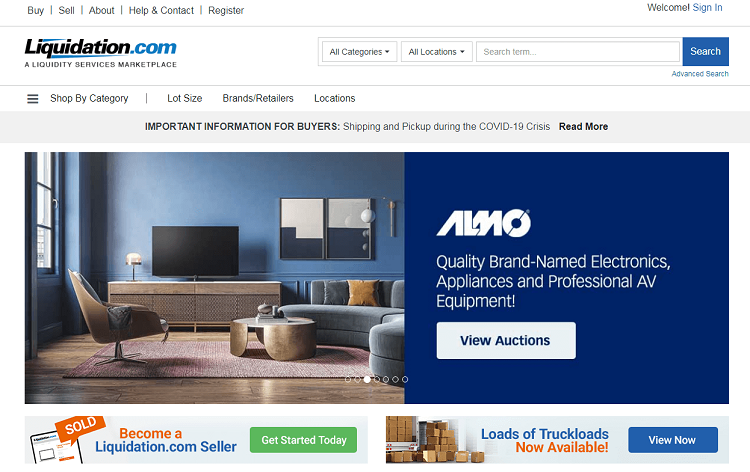
Liquidation.com is a company that sells clearance lots from Amazon and various other companies.
Lots are sold by the truckload, pallet, or box. The merchandise sold varies in condition but is mainly electronics, houseware, apparel, industrial, computer, and vehicle categories.
Lots are sold by auction, and bidding usually starts at $100.
In addition, some lots are available for immediate purchase.
To place a bid or make a purchase, you first register with liquidation.com.
Non-US customers have to make wire transfer payments. It is also a requirement for any purchases over $5,000.
Pros:
- Cost-effective pricing: Liquidation platforms often offer discounted prices on returns pallets, allowing buyers to potentially acquire items at a lower cost compared to retail.
- Diverse product options: Liquidation offers a wide range of merchandise, including clothing, electronics, home goods, and more, providing opportunities to cater to different markets.
- Potential for high-profit margins: Buyers can find valuable items or resellable merchandise within liquidation pallets, allowing for potential profit generation.
Cons:
- Variable item conditions: Liquidation pallets may contain a mix of used, damaged, or unclaimed items, requiring additional effort for repair, refurbishment, or resale.
- Limited or no warranties: Depending on the platform and seller, there may be no warranty coverage or guarantees on the condition or functionality of the purchased items.
- Competition and limited availability: Popular liquidation platforms can attract a high number of buyers, leading to increased competition for desirable items and limited availability of certain products.
BULQ
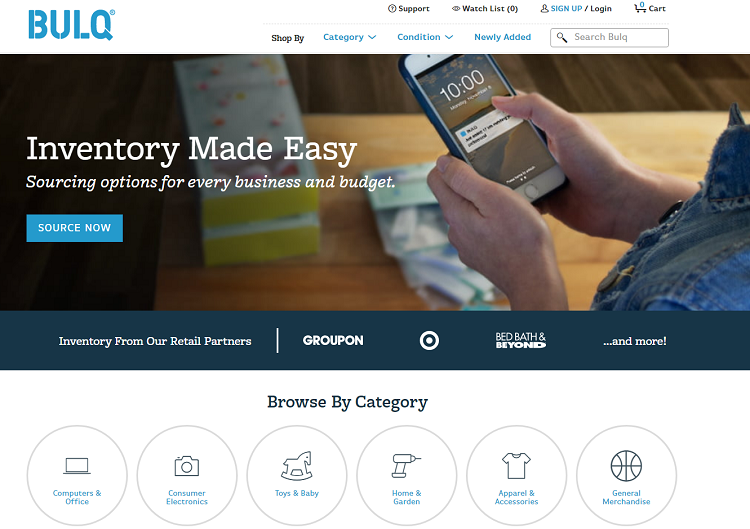
BULQ is another US-based liquidation company that deals directly with retailers and sellers. One of those is Amazon.
New items for sale are listed three times every day.
Prices vary depending on the seller. Some prices are fixed, while others run via a 48-hour auction.
Registration is not essential if all you want is to browse the clearance section.
However, if you find something you’d like to purchase, you must register. Resale certificates are also part of the deal for all customers.
Returns or exchanges are not possible on pallets or lots.
Shipping is to US addresses only, and for some cases, there is a $30 flat shipping fee to pay.
The cost to ship a pallet depends on the weight, dimension, and distance from the warehouse to your address.
Pros:
- Wide range of merchandise: BULQ offers a diverse selection of liquidation pallets, including clothing, electronics, home goods, toys, and more.
- Transparent sourcing information: BULQ provides detailed manifest information, including the condition, brand, and category of items within each pallet, helping buyers make informed decisions.
- Reseller-friendly platform: BULQ is designed with resellers in mind, offering features like bulk purchasing options, discounted prices, and access to a community of resellers.
Cons:
- Potential for damaged or unsellable items: As with any liquidation purchase, there is a risk of receiving items that are damaged, defective, or not suitable for resale.
- Limited control over pallet contents: While manifest information is provided, buyers may have limited ability to customize or choose specific items within a pallet.
- Shipping costs and logistics: Buyers are responsible for arranging and covering the costs of shipping and handling, which can vary based on location and pallet size.
DirectLiquidation
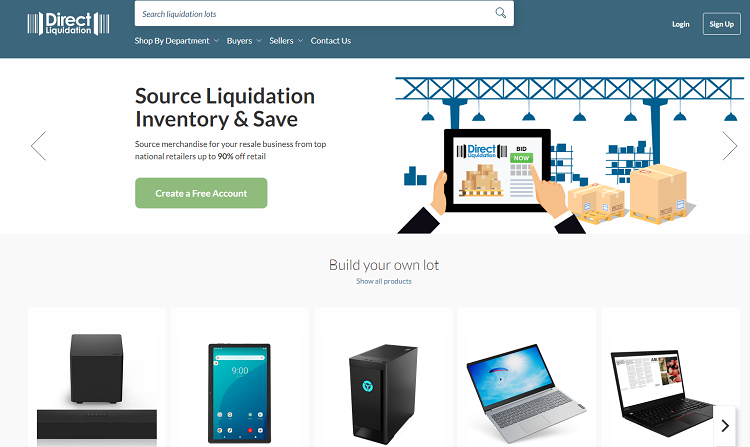
A lot of DirectLiquidation’s business is with Amazon, but they also work with other well-known box stores like Walmart, Home Depot, and Target.
When you visit the website, you can perform searches by brand or store.
All sales are conducted by auction, but you have to register for an account before bidding on a pallet.
Pros:
- Wide range of inventory: DirectLiquidation offers a diverse selection of liquidation pallets and truckloads across various categories, including electronics, appliances, furniture, and more.
- Verified wholesale sourcing: DirectLiquidation works directly with major retailers and manufacturers, ensuring the authenticity and quality of the merchandise.
- Competitive pricing: Buyers can access discounted prices on a wide range of products, providing potential for cost-effective sourcing and higher profit margins.
Cons:
- Variable item conditions: As with any liquidation purchase, buyers should be aware that items may vary in condition, including used, customer returns, or damaged goods.
- Potential for minimum order requirements: Certain pallets or lots may have minimum purchase quantity restrictions, which may not be suitable for small-scale or individual buyers.
- Limited warranty coverage: Depending on the condition of the items, there may be limited or no warranty coverage for purchased merchandise.
888 Lots
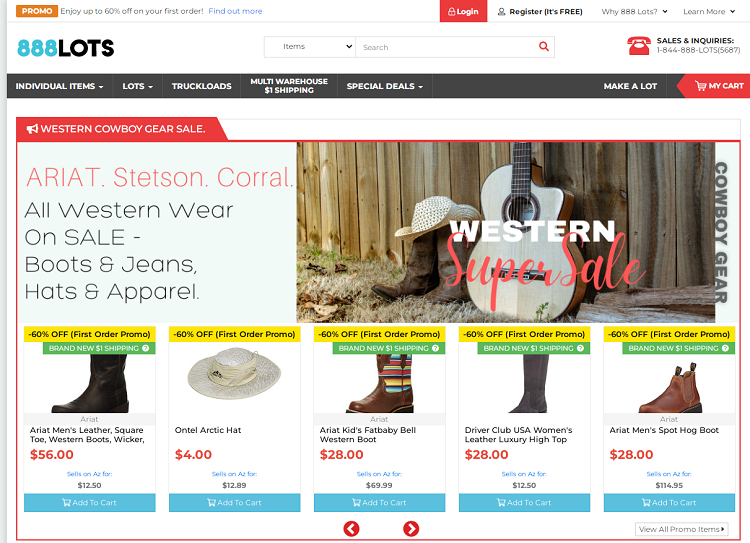
888 Lots only have Amazon pallets for sale that contain brand-new merchandise.
The details they provide on their website include the Amazon sales rank, product images, item descriptions, condition, ASIN, and Amazon reviews rank.
You’ll also be able to see estimated profits for each item.
They sell both small, individual Amazon pallets and oversized bulk pallets.
There is no minimum order, and no maximum amount you’re allowed to spend, but you must purchase the full pallet or SKU.
888 Lots require a valid resale certificate for customers based in the US. For non-US customers, valid business registration is required.
Shipping costs are $12.00 per box for lots. Pallet shipping costs vary depending on size and weight.
You’re also given the option to arrange your own shipping if you prefer.
Pros:
- Extensive product categories: 888 Lots offers a wide range of liquidation merchandise, including electronics, clothing, jewelry, home goods, and more, providing buyers with diverse sourcing options.
- Auction and fixed-price options: Buyers can choose between auction-style bidding or fixed-price listings, allowing for flexibility in purchasing and finding the best deals.
- Verified and reputable sellers: 888 Lots works with trusted liquidators and retailers, ensuring the quality and authenticity of the products being offered.
Cons:
- Variable product conditions: Buyers should be aware that liquidation merchandise may vary in condition, including used, customer returns, or damaged items, requiring additional effort for inspection and potential refurbishment.
- Shipping and handling costs: Buyers are responsible for arranging and covering the costs of shipping and handling, which can add to the overall expenses of purchasing from 888 Lots.
- Limited warranty coverage: Depending on the individual seller and product conditions, there may be limited or no warranty coverage for the purchased items.
BlueLots
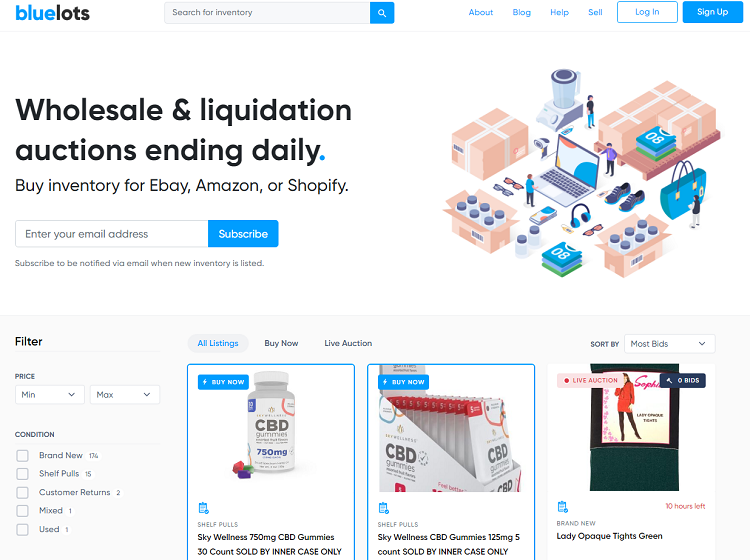
BlueLots is another US-based company that sells returns from some of the largest brands, including Amazon.
BlueLots doesn’t add a markup to their inventory. Instead, they make their profit by charging the retailers directly.
You can browse the clearance without making an account. However, you’ll need to register on the website for the entire inventory.
Shipping options include UPS, FedEx, and USPS. The cost of shipping depends on the size and weight of each pallet.
You can expect to pay between $300 and $400 per pallet.
Pros:
- Wide range of liquidation inventory: BlueLots offers a diverse selection of liquidation merchandise, including apparel, accessories, home goods, electronics, and more.
- Verified and trusted sourcing: BlueLots partners with reputable retailers and brands, ensuring the authenticity and quality of the products being offered.
- Easy-to-use platform: BlueLots provides a user-friendly interface, making it convenient for buyers to navigate and find relevant liquidation lots for their business needs.
Cons:
- Minimum order requirements: Some lots on BlueLots may have minimum purchase quantity restrictions, which may not be suitable for small-scale or individual buyers.
- Variable product conditions: Buyers should be aware that liquidation merchandise can vary in condition, including used, customer returns, or imperfect items, requiring thorough inspection and potential refurbishment.
- Shipping and logistics: Buyers are responsible for arranging and covering the costs of shipping and handling, which can vary based on location and lot size.
BoxFox
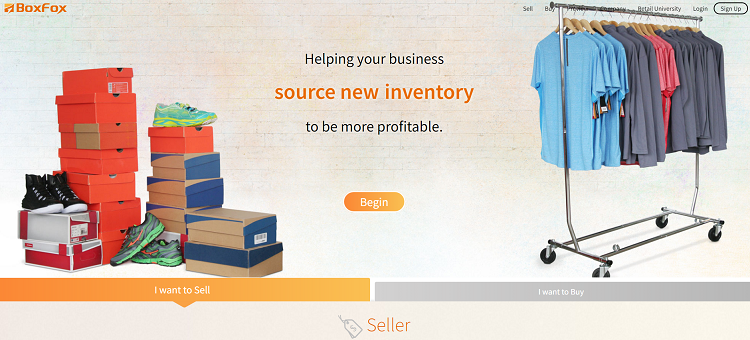
BoxFox is a company that sells Amazon and other branded pallets by auction directly from their retailers, for example, the Amazon warehouse.
Registration is free, and you can download an app to keep track of live auctions.
BoxFox only sells Amazon overstock, not returns. Their selling policy is only to sell merchandise that’s brand new.
Appraisal values are set for each product, but buyers can bid above or below the specified amount.
Pros:
- Wide range of used and overstock inventory: BoxFox offers a variety of liquidation merchandise, including clothing, accessories, home goods, and more, providing buyers with diverse sourcing options.
- Transparent product information: BoxFox provides detailed information about each lot, including condition notes, brand names, and manifest details, enabling buyers to make informed purchasing decisions.
- Easy bidding and purchasing process: BoxFox’s platform allows for straightforward bidding and buying, making it convenient for buyers to participate in auctions and secure desired inventory.
Cons:
- Competitive bidding environment: Due to the popularity of BoxFox, there can be high competition for desirable lots, potentially driving up prices and reducing profit margins.
- Limited returns and warranty options: BoxFox typically offers limited or no returns on purchased lots, and warranties may not be provided, so buyers should carefully assess the condition and suitability of items before bidding.
- Shipping and handling costs: Buyers are responsible for arranging and covering the costs of shipping and handling, which can vary based on location and lot size, potentially adding to the overall expenses.
Tips on Buying Amazon Returns For Sale
Purchasing the returns pallet is the easy part.
Now you’ve got to think about how you can maximize your potential profits and upscale the contents as much as possible.
The products you purchase in an Amazon pallet are typically untested.
What this means for you is that the items will be in various conditions.
Some will be ready for you to sell right away, while some will need repairs.
Let’s give you some tips on how you can squeeze as much profit from your Amazon Returns pallet purchase.
Sort and Bundle
Before you can do anything, you first have to sort through your pallet to see what it is you’ve purchased.
It’s a good idea to sort the items into two piles.
One pile is for things that you can sell straight out of the box and the second pile is for items that might need some kind of attention.
While you’re looking at the items, consider whether some might be more attractive when sold as a bundle.
Repair
Some of the items on the pallet may need to be repaired or refurbished. For example, this is often the case with electronics.
Ideally, you want to try and repair and refurbish yourself, as this will save money.
The repairs needed will often be minor, quick, and easy to fix.
Once you’ve done this, the products will be back up to factory specifications and have a higher sale value.
If your pallets contain several similar faulty items, you might be able to take components from one model and use it to repair another and bring them up to spec.
Keep hold of any broken products that you can’t repair or refurbish, as these could be very useful for spares and repairs.
Pick Needed Accessories
A common reason for products to be returned is that certain vital accessories are missing, such as headphones or chargers.
Accessories like these are often easy and cheap to replace.
If you can sell a product with all its accessories, it will add value and allow you to sell it for a higher price.
Repack
You may need to repackage some of the items as the packaging a product is sold in is often damaged.
If possible, try to get hold of the original replacement packaging or repackage the product.
The way a product is packaged can affect its value.
Did you know, for example, that 67% of American consumers say paper and cardboard-based packaging makes a product more attractive than other packaging materials?
You should try to make the packaging original if possible, but if you can’t get the original packaging, make sure what you use is good quality, pristine, plain packaging.
Inspect
You should inspect all your products carefully. Items for reselling also have to be advertised with a grade.
Your items should fit into one of the following categories:
- New factory-sealed: The item is brand-new and still in its original packaging. The item has never been opened, is still in the factory plastic wrapping, and pristine condition.
- New open-box: The item is new and in perfect condition. However, the packaging has been opened.
- Refurbished: A refurbished item will be inspected, repaired if necessary, accessorized, and repackaged.
- Used: A used item is functional, but it will have signs of wear and tear that might include dents or scratches.
One final tip is to remove any original manufacturer’s warrant from any products you resell.
The warranties are no longer valid, so the cards included with the products should be removed and discarded.
Can You Make Money by Buying and Selling Amazon Return Pallets?
Well, that’s a million-dollar question if ever there was one.
But yes, you can make money, but how much depends on the amount of effort you want to put in.
If you are meticulous and spend time refurbishing, accessorizing, bundling, and repackaging items, you should be able to make a decent enough profit.
However, you should research every Amazon return pallet you purchase.
Then, look up every item (if that information is available) on eBay and Amazon to calculate your potential profit.
Evaluate the cost of each piece in the pallet and its potential selling price.
Remember to include a weighing factor that accounts for broken merchandise.
You might be interested to check those related posts as well:
- How to Archive Amazon Orders?
- Amazon Orders Pending [in 2024]: What Does It Mean
- Amazon Liquidation Program 2024 [9 Best Liquidation Tips]
Conclusion
Buying and selling Amazon returns can be exhilarating and fun.
Best of all, you don’t need to have a considerable amount of storage space.
You can send most of the products in the pallet back to Amazon’s warehouses for resale.
Alternatively, you can list them on eBay. You don’t need to make a massive investment or have any technical skills to start.
Now you know where to buy Amazon liquidation pallets, you’re already off to a good start.
